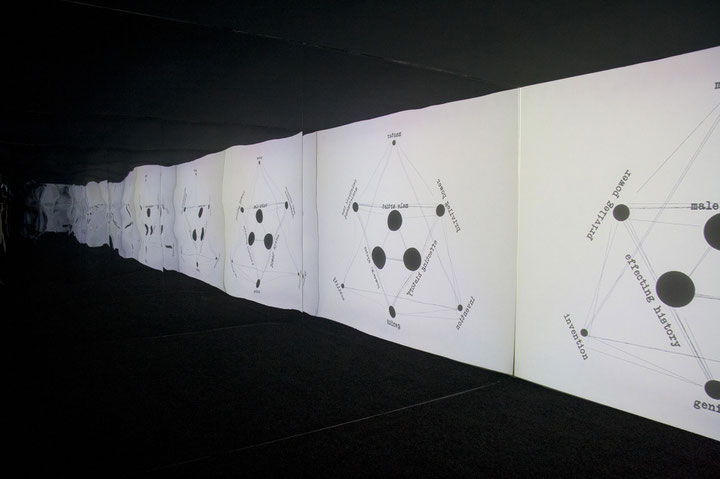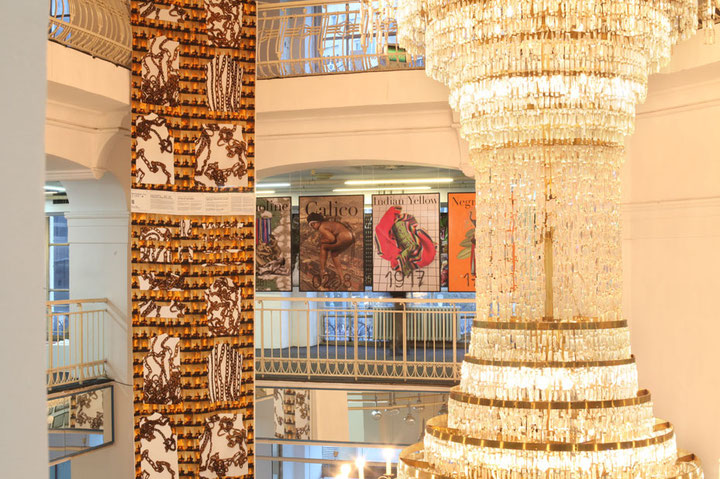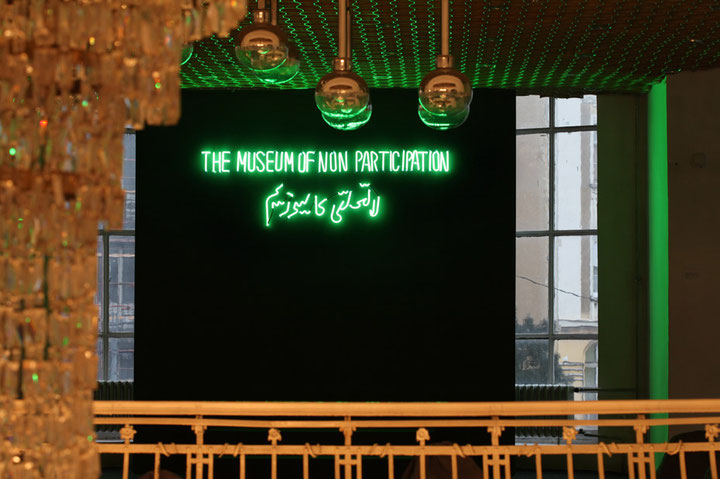Issue 1/2014 - Chronic Times
Politics of space and time
On the Non-linear Chronologies of the Living Archive Project
The Living Archive project (abbreviated as: LA) strives to create experimental constellations of feminist thought on contemporary art and its contemporary participative practice. In the process it also calls into question the politics of space and time in general. The LA takes material form in each case as a (re-)productive and participatory “edition” – individual interactive exhibitions with the current moment as the point of departure, which means that it creates a momentum, which for its part generates and shapes discourses of time. The LA thus breaks with linear chronologies through the experimental montage of temporal windows, each of which insists on its topicality. The focus is on the history of the present and the present of history – or both simultaneously. .
The LA began as the long-term project of the feminist curators’ group Red Min(e)d, and was titled The Bring In Take Out Living Archive. Its first edition unfolded in 2011 in the framework of the international feminist conference REDacting Trans-Yugoslav Feminisms: Women’s Heritage Revisited in Zagreb, which was organised by the post-Yugoslavian gender and women’s studies-network of Red Athena University.
Right from the outset the LA – mostly in conjunction with other initiatives, academic institutions or groups – addressed the topic of the ways in which feminism can have an impact on the exhibition methods for contemporary art. In this context, the questions that arose were related not solely to time (which historic clichés are active? How is archiving done? How does production occur and how is historic knowledge institutionalised) but also to place (in essence the feminist question concerning the complex and still undefined political map of post-Yugoslavia, with us moving closer to this “territory” through theoretical, artistic, activist and curatorial measures and positions). The curatorial goal was to establish the LA as an institution that functioned spatially like a polis in Hannah Arendt’s sense of the term, which means not as a geographically determined city-state, but rather an “the organization of the people in the form in which it arises from existing and talking together”, whose “true space lies between people living together for this purpose, no matter where they happen to be.” 1
This approach to understanding the archive as an interactive space is faced with many difficult questions that await answers. However, it does make it possible to integrate a multitude of the contemporary (individual and collective) positions that invoke feminism. Viewed in this light, the LA has the potential to (re)configure feminist politics in the art and curatorial realm through a shared conception of space and time. The LA insists on what a feminist avantgarde must still achieve, not on what feminism is or was.
As it represents the interactions between feminism, contemporary art and the situation in post-Yugoslavia, the LA gives the term “positioning” an unconventional new meaning. As the foundation of all thinking, action and life, it defines feminist friendship. This makes it possible to switch between individual and collective practices, as well as between political thought and public discourse. According to Michel Foucault, all these things exist in a twofold relationship with power: they are both an effect and an instrument of power, In the light of the additional fact that public discourse always emanates from a position of power, the LA seeks constructive answers to the following critical questions: Who is talking in whose name? Why are the traditional fora of political discourse gradually disintegrating? Who delegates what to whom? In other words: how can one (publicly or in academic realms) talk for a majority, primarily women? In dealing with these problems the overarching questions arises of whether there can anyway be a revolutionary social movement in the art business that puts the ideals of a feminist avant-garde into practice in everyday life.
With this discourse the LA in any event calls into question the notion of a linear space-time continuum, within which no new material practices can be conceived. From which position can we define this continuum as so egalitarian and emancipatory that interventions become possible after all? How is it possible with art to create a generally accessible archive of knowledge that ensures the continuity of revolutionary thought and emancipatory action? The discursive interfaces where such questions could be resolved lie between contemporary art and the process of archiving, which is co-shaped by social relationships and the producers’ biographies.
One possible point of departure would be the assertion that archiving contemporary art is an act of collecting, classifying, objectivising and conserving revolutionary though and action. In this capacity it does not produce any public discourse but rather destroys such discourse. In an archive that historicises art, any kind of modern art ceases to be modern and thus ceases to be politically effective. Separating art out from its historical-material circumstances and social relationships simultaneously neutralises its current and future-oriented topics.
It is precisely this that the “living archive” as a feminist concept aims to counteract. The living archive does not generate history and knowledge by official canonisation of events and theories. Instead it is a counter-archive that comes into being in and through art itself and which takes as its topic unmediated political and social life. The living archive is a public and political place that only exists as long as a discourse about it exists – and indeed not a discourse of individuals, but the discourse of society as a whole.
These are the reasons why an archive for contemporary art can only be understood in discursive and process-based terms. It always exists in the futur antérieur – in the pre-future, which creates a divide between the past and the present in the construction of the future. In a nutshell: revolutionary art can only constitute a caesura if it politicises time and space. In addition, revolutionary art creates a theory of systems of discourse for which the way has been paved by existing caesurae. Michel Foucault refers in this context to societal production of a public discourse:
“The key-notions required by historical research are no longer those of consciousness and continuity (with their correlative problems of freedom and causality), nor any longer those of sign and structure, but those of the event and the series (with the related notions of regularity, unpredictability, discontinuity, dependence, transformation).”.2
The LA Method
Everything in the LA begins with feminist friendship. It is the point of departure for artistic processes, but also for the choice of artists, concepts, works, discussion events and participants, as well as for selecting the context for each individual edition of the LA. The group Red Min(e)d nurtures alliances that came into being through individual and shared experiences. These can be traced back to the construction of a post-Yugoslavian women’s network in the framework of the Red Athena University Press, the feminist-queer festival Red Dawns from Ljubljana, the BeFem Festival in Belgrade, as well as to various other groups, institutions and events. The latest in this series was the 54th October Salon in 2013 in Belgrade, an annual art exhibition.3
With its experimental, cooperative and modular approach, the LA creates a feminist laboratory. As a (counter) archive, it appears in ever-new editions in different locations (to date, these were Zagreb, Ljubljana, Sarajevo, Vienna and Belgrade) and in the process generates an interactive space. Its discursive and performative formats are in the throes of permanent change. The LA analyses feminist academic views, methods and paradigms in order to utilise public space as an emancipatory realm for social encounters, sharing of knowledge and art production. The actions undertaken by the LA are interventionist (with a focus on current topics related to each respective location and context), intensive (i.e. running for several days) and multimedia. Each edition of the LA deploys various formats in the process, such as discussions, film screenings, talks with artists, parties or actions. These practices cut across the conventional borderlines between private and public and are therefore also dubbed “(non-) work stations)”.
The “(non-)behavioural rules” of the LA can in turn be found in our manual How Not to Behave, which is available at every edition. It is mostly needed when we call into question the routines of art institutions (galleries, museums, art spaces) to such an extent that a discourse, indeed often a real “struggle” for the social aspect of art, comes into being.
The collective Red Min(e)d has been involved in every edition of LA so far. As a result, not only did the tangible impact of feminism on art become visible, but above all curating on the basis of feminist friendship was achieved within the exhibition practice. It is only in this way that a political basis for new artistic and curatorial practices can come into being. Consequently, in every edition, and with every public appearance, LA must grapple with the problem of “inclusion” and “exclusion”. That is the only way for it to create a space of political art production. Participants and the audience together create an event rooted in solidarity, in which modern feminist knowledge and new historical interpretations can be exchanged.
Our platform does not seek to undermine the existing public space, but to indicate, loud and clear, new strategies of societal emancipation. In doing this, the LA creates a space for loud (feminist) articulation. Feminist Biljana Kasić noted during a discussion that the idea of the living archive “aims at an open space, which is new and decentralised, visibly present and yet invisible, which enables free experiments and hence the politicisation of space and time.” 4
Red Min(e)d understands the art that comes into being in the LA as non-permanent and experimental. It is a multi-dimensional expression of an ongoing research and work process that calls into question seemingly unchangeable academic and institutional systems and perhaps also succeeds in creating new systems.
1 Hannah Arendt, The Human Condition. Chicago 1958, p. 199.
2 Michel Foucault, The Will to Power. Frankfurt am Main 1991, p. 127.
3 http://oktobarskisalon.org
4 Biljana Kašić, Creating A Feminist Archive Means Facing The Real to the Most Extent, LA-Discussion, Ljubljana, 9th March 2012.


